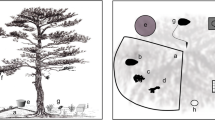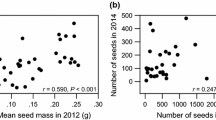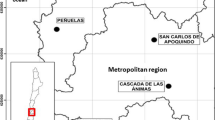Abstract
Tropical tree species vary widely in their pattern of spatial dispersion. We focus on how seed predation may modify seed deposition patterns and affect the abundance and dispersion of adult trees in a tropical forest in India. Using plots across a range of seed densities, we examined whether seed predation levels by terrestrial rodents varied across six large-seeded, bird-dispersed tree species. Since inter-specific variation in density-dependent seed mortality may have downstream effects on recruitment and adult tree stages, we determined recruitment patterns close to and away from parent trees, along with adult tree abundance and dispersion patterns. Four species (Canarium resiniferum, Dysoxylum binectariferum, Horsfieldia kingii, and Prunus ceylanica) showed high predation levels (78.5–98.7%) and increased mortality with increasing seed density, while two species, Chisocheton cumingianus and Polyalthia simiarum, showed significantly lower seed predation levels and weak density-dependent mortality. The latter two species also had the highest recruitment near parent trees, with most abundant and aggregated adults. The four species that had high seed mortality had low recruitment under parent trees, were rare, and had more spaced adult tree dispersion. Biotic dispersal may be vital for species that suffer density-dependent mortality factors under parent trees. In tropical forests where large vertebrate seed dispersers but not seed predators are hunted, differences in seed vulnerability to rodent seed predation and density-dependent mortality can affect forest structure and composition.



Similar content being viewed by others
References
Augspurger CK (1984) Seedling survival of tropical tree species: interactions of dispersal distance, light gaps and pathogens. Ecology 65:1705–1712. doi:10.2307/1937766
Baddeley A, Turner R (2005) Spatstats: an R package for analyzing spatial point patterns. J Stat Softw 12:1–42
Bell T, Freckleton RP, Lewis OT (2006) Plant pathogens drive density-dependent seedling mortality in a tropical tree. Ecol Lett 9:569–574. doi:10.1111/j.1461-0248.2006.00905.x
Bricker M, Pearson D, Maron J (2010) Small-mammal seed predation limits recruitment and abundance of two perennial grassland forbs. Ecology 91:85–92. doi:10.1890/08-1773.1
Brown JH, Heske EJ (1990) Control of a desert-grassland transition by a keystone rodent guild. Science 250:1705–1707. doi:10.1126/science.250.4988.1705
Champion HG, Seth SK (1968) A revised survey of the forest types of India. Manager of Publications, New Delhi
Chapman CA, Chapman LJ (1995) Survival without dispersers: seedling recruitment under parent trees. Conserv Biol 9:675–678
Clark DA, Clark DB (1984) Spacing dynamics of a tropical rain forest tree: evaluation of the Janzen-Connell model. Am Nat 124:769–788
Clark PJ, Evans CF (1954) Distance to nearest neighbour as a measure of spatial relationships in populations. Ecology 35:445–452
Condit R, Hubbell SP, Foster RB (1992) Recruitment near conspecific adults and the maintenance of tree and shrub diversity in a neotropical forest. Am Nat 140:261–286
Connell JH (1971) On the role of natural enemies in preventing competitive exclusion in some marine animals and in rainforest trees. In: den Boer J, Gradwell GR (eds) Dynamics of populations. PUDOC, Wageningen, pp 298–312
Cordeiro NJ, Howe HF (2003) Forest fragmentation severs mutualism between seed dispersers and an endemic African tree. Proc Natl Acad Sci USA 100:14052–14056. doi:10.1073/pnas.2331023100
Crawley MJ (1992) Seed predators and plant population dynamics. In: Fenner M (ed) Seeds: the ecology of regeneration in plant communities. CABI, Wallingford, pp 167–182
Datta A (2001) An ecological study of sympatric hornbills and fruiting patterns of a tropical rainforest in Arunachal Pradesh, Northeast India. PhD dissertation, University of Saurashtra, Rajkot
Datta A, Goyal SP (2008) Responses of diurnal tree squirrels to selective logging in western Arunachal Pradesh. Curr Sci 95:895–902
Datta A, Rawat GS (2008) Dispersal modes and spatial patterns of tree species in a tropical forest in Arunachal Pradesh, northeast India. Tropical Conserv Sci 1:163–185
Edwards GR, Crawley MJ (1999) Rodent seed predation and seedling recruitment in mesic grassland. Oecologia 118:288–296
Fragoso JMV (1997) Tapir-generated seed shadows: scale-dependent patchiness in the Amazon rain forest. J Ecol 85:519–529
García D, Obeso JR, Martínez I (2005) Rodent seed predation promotes differential recruitment among bird-dispersed trees in temperate secondary forests. Oecologia 144:435–446. doi:10.1007/s00442-005-0103-7
Harms KE, Wright SJ, Calderón O, Hernández A, Herre EA (2000) Pervasive density-dependent recruitment enhances seedling diversity in a tropical forest. Nature 404:493–495. doi:10.1038/35006630
Harper JL (1977) Population biology of plants. Academic, London
Howe HF (1989) Scatter and clump dispersal and seedling demography: hypothesis and implications. Oecologia 79:417–426
Howe HF, Brown JS (2000) Early consequences of rodent granivory on synthetic dicot communities. Ecol Appl 10:917–924. doi:10.1890/10510761(2000)010[0917:EEORGO]2.0.CO;2
Hubbell SH (1979) Tree dispersion, abundance and diversity in a tropical dry forest. Science 203:1299–1309
Hulme PE (1994) Post-dispersal seed predation in grassland: its magnitude and sources of variation. J Ecol 82:645–652
Janzen DH (1970) Herbivores and the number of tree species in tropical forests. Am Nat 104:501–527
Janzen DH (1971) Seed predation by animals. Annu Rev Ecol Syst 2:465–492
Kollmann J, Coomes DA, White SM (1998) Consistencies in post-dispersal seed predation of temperate fleshy-fruited species among seasons, years and sites. Funct Ecol 12:683–690
Lieberman M, Lieberman D (1994) Patterns of density and dispersion of forest trees. In: McDade LA, Bawa KS, Hespenheide HA, Hartshorn GS (eds) La Selva: ecology and natural history of a neotropical rain forest. University of Chicago Press, Chicago, pp 106–119
Louda SM (1982) Distribution ecology: variation in plant recruitment over a gradient in relation to insect seed predation. Ecol Monogr 52:25–41
Maron JL, Simms EL (1997) Effect of seed predation on seed bank size and seedling recruitment of bush lupine (Lupinus arboreus). Oecologia 111:76–83
Orrock JL, Levey DJ, Danielson BJ, Damschien EI (2006) Seed predation, not seed dispersal, explains the landscape-level abundance of an early-successional plant. J Ecol 94:838–845. doi:10.1111/j.1365-2745.2006.01125.x
Paine CET, Beck H (2007) Seed predation by neotropical rain forest mammals increases diversity in seedling recruitment. Ecology 88:3076–3087
Paine CET, Harms KE, Schnitzer SA, Carson WP (2008) Weak competition among tropical tree seedlings: implications for species coexistence. Biotropica 40:432–440. doi:10.1111/j.1744-7429.2007.00390.x
Rey PJ, Garrido JL, Alcantára JM, Ramírez JM, Aguilera A, García L, Manzaneda AJ, Fernández R (2002) Spatial variation in ant and rodent post-dispersal predation of vertebrate-dispersed seeds. Funct Ecol 16:773–781
R Development Core Team (2009) R: a language and environment for statistical computing. R Foundation for Statistical Computing, Vienna, Austria http://www.R-project.org
Romo M, Tuomisto H, Loiselle BA (2004) On the density-dependence of seed predation in Dipteryx micrantha, a bat-dispersed rain forest tree. Oecologia 140:76–85. doi:10.1007/s00442-004-1502-x
Russo SE (2005) Linking seed fate to natural dispersal patterns: factors affecting predation and scatter-hoarding of Virola calophylla seeds in Peru. J Trop Ecol 21:243–253. doi:10.1017/S0266467405002312
Russo SE, Augspurger CK (2004) Aggregated seed dispersal by spider monkeys limits recruitment to clumped patterns in Virola calophylla. Ecol Lett 7:1058–1067. doi:10.1111/j.1461-0248.2004.00668.x
Schupp EW (1990) Annual variation in seedfall, post-dispersal predation and recruitment of a neotropical tree. Ecology 71:504–515
Schupp EW (1992) The Janzen-Connell model for tropical tree diversity: population implications and the importance of spatial scale. Am Nat 140:526–530
Seidler TG, Plotkin JB (2006) Seed dispersal and spatial pattern in tropical trees. PLoS Biol 4:2132–2137. doi:10.1371/journal.pbio.0040344
Sethi P, Howe HF (2009) Recruitment of hornbill-dispersed trees in hunted and logged forests of the Indian Eastern Himalaya. Conserv Biol 23:710–718. doi:10.1111/j.1523-1739.2008.01155.x
Siepielski AM, Benkman CW (2008) Seed predation and selection exerted by a seed predator influence subalpine tree densities. Ecology 89:2960–2966
Stiles EW (1989) Fruits, seeds, and dispersal agents. In: Abraham WG (ed) Plant–animal interactions. McGraw-Hill, New York, pp 87–122
Terborgh J, Pitman N, Silman M, Schichter H, Percy Nunez V (2002) Maintenance of tree diversity in tropical forests. In: Levey DJ, Silva WR, Galetti M (eds) Seed dispersal and frugivory: ecology, evolution and conservation. CABI, Wallingford, pp 1–17
Therneau TM (2009) http://www.cran.rproject.org/web/packages/coxme/index.html
Therneau TM, Grambsch PM (2000) Modeling survival data: extending the Cox model (statistics for biology and health). Springer, New York
Tutin CEG, Williamson EA, Rogers ME, Fernandez M (1991) A case study of a plant-animal relationship: cola lizae and lowland gorillas in the Lope′ Reserve, Gabon. J Trop Ecol 7:181–199
Uriarte M, Condit R, Canham CD, Hubbell SH (2004) A spatially explicit model of sapling growth in a tropical forest: does the identity of neighbours matter? J Ecol 92:348–360
Velho N, Datta A, Isvaran K (2009) Effect of rodents on seed fate of five hornbill-dispersed tree species in a tropical forest in north-east India. J Trop Ecol 25:507–514. doi:10.1017/S0266467409990083
Wenny DG (2000) Seed dispersal, seed predation, and seedling recruitment of Ocotea endresiana (Lauraceae) in Costa Rica. Ecol Monogr 70:331–351
Wenny DG, Levey DJ (1998) Directed seed dispersal by bellbirds in a tropical cloud forest. Proc Natl Acad Sci USA 95:6204–6207
Wright SJ (2002) Plant diversity in tropical forests: a review of mechanisms of species coexistence. Oecologia 130:1–14. doi:10.1007/s004420100809
Wright SJ, Muller-Landau HC, Calderón O, Hernández A (2005) Annual and spatial variation in seedfall and seedling recruitment in a neotropical forest. Ecology 86:848–860
Wright SJ, Stoner KE, Beckman N, Corlett RT, Dirzo R, Muller-Landau HC, Nuñez-Iturri G, Peres CA, Wang BC (2007) The plight of large animals in tropical forests and the consequences for plant regeneration. Biotropica 39:289–291. doi:10.1111/j.1744-7429.2007.00293.x
Zhang H, Zhang Z (2008) Endocarp thickness affects seed removal speed by small rodents in a warm-temperate broad-leafed deciduous forest, China. Acta Oecol 34:285–293. doi:10.1016/j.actao.2008.06.001
Acknowledgments
This work was funded by the Wildlife Conservation Society–India Program. The Nature Conservation Foundation, Mysore, helped with logistics and equipment. We thank the Arunachal Pradesh Forest Department for granting permission and facilitating the fieldwork. All experiments in this study comply with current Indian laws. Kishore Dorje, Kumar Thappa, Tagge Talang, Rajan Bahadur, Rasham Barra and Narayan Mogar made this work possible with their immense support in the field. Suhel Quader, Jason Tylianakis, Robert Chandran and T.M. Therneau helped with data analyses. Geoff Hyde and Ajith Kumar helped with the structure and content of this manuscript. Umesh Srinivasan helped at all stages of the manuscript, especially ensuring its completion. We thank Eugene Schupp, Maurie Beck and Walter P. Carson for valuable comments that helped improve our manuscript.
Author information
Authors and Affiliations
Corresponding author
Additional information
Communicated by Walt Carson.
Electronic supplementary material
Below is the link to the electronic supplementary material.
Rights and permissions
About this article
Cite this article
Velho, N., Isvaran, K. & Datta, A. Rodent seed predation: effects on seed survival, recruitment, abundance, and dispersion of bird-dispersed tropical trees. Oecologia 169, 995–1004 (2012). https://doi.org/10.1007/s00442-012-2252-9
Received:
Accepted:
Published:
Issue Date:
DOI: https://doi.org/10.1007/s00442-012-2252-9




